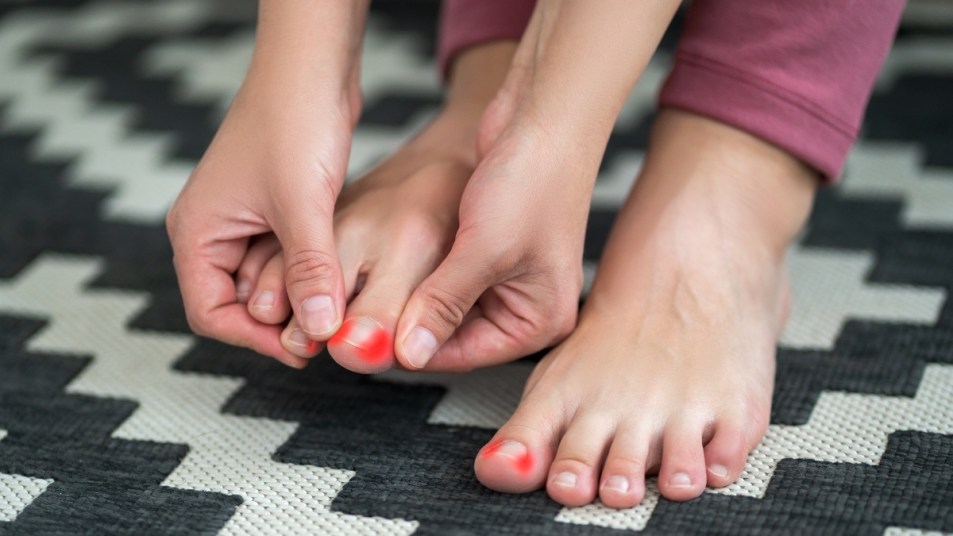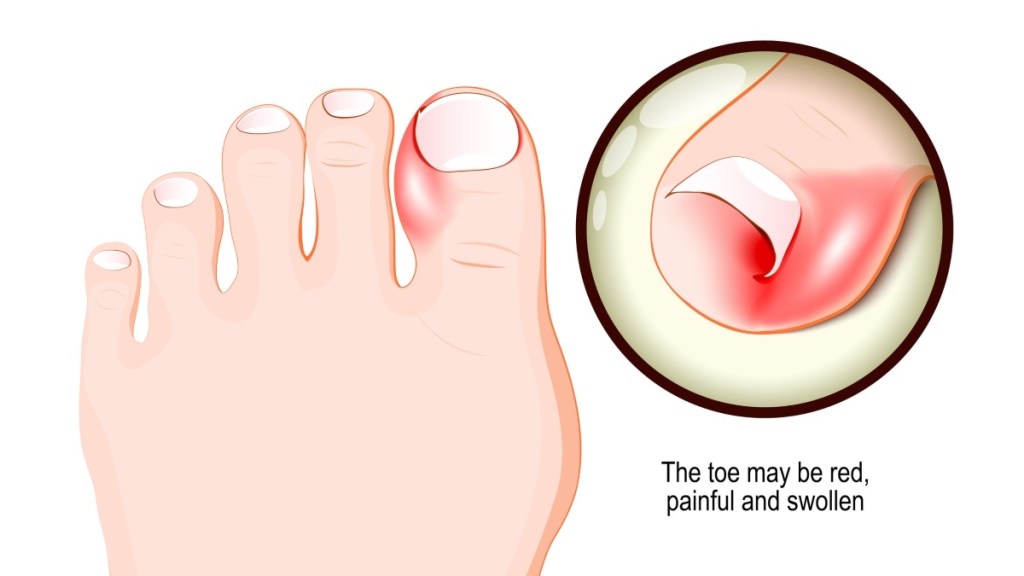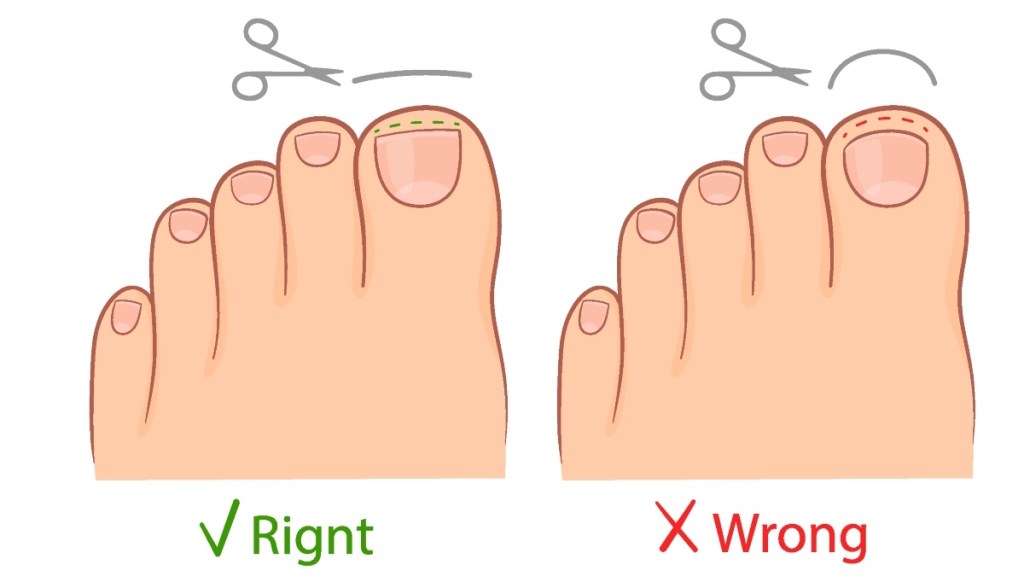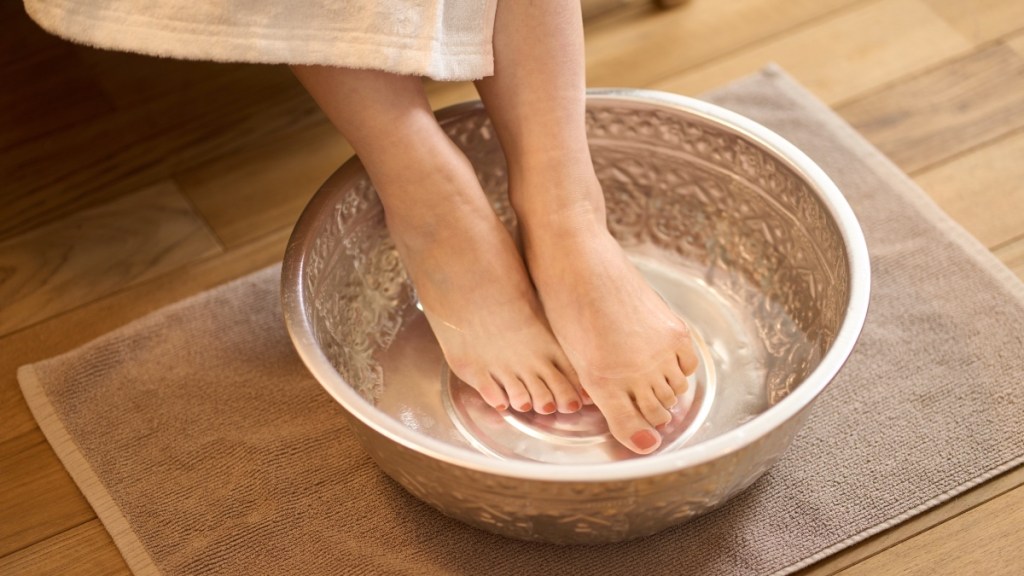How to Remove an Ingrown Toenail Yourself + The Dental Floss Hack That’s All Over TikTok
Find out why a podiatrist says soaking in cold water — not warm — is better for ingrown toenails

If you’re prone to ingrown nails, you’ve probably wondered how to remove an ingrown toenail yourself. After all, doing so can save you a trip to the doctor and prevent complications like infection. TikTok and YouTube are filled with hacks like placing dental floss under the ingrown toenail or using cotton to help lift the nail. But do these tricks actually work? And, if they do, how can you perform them safely? Podiatrists weigh in on the ingrown toenail self-care remedies you can try at home and when you should see a pro.
What is an ingrown toenail?
An ingrown toenail occurs “when the nail plate [the toenail itself] impinges or sticks into the surrounding flesh of the toe,” explains Michael J. Trepal, DPM, FACFAS, a practicing podiatrist with more than 30 years of experience and the Dean of the New York College of Podiatric Medicine. It can affect any toe, but it’s most common on the big toe. Why? They’re closest to the edge of your shoes and more likely to become pinched.
As the nail grows, the surrounding skin can fold over or under the ingrown nail, causing pain and inflammation. “In more severe cases, the nail can puncture the tissue, allowing bacteria to get in,” Dr. Trepal explains. “This results in an infected ingrown toenail, which really hurts. There’s a lot of nerve endings in the tips of the toes making the sensation all the more painful.”
Common symptoms of an ingrown toenail include:
- Inflamed (red) skin
- Swelling at the edge of the nail
- Pain
- Sensitivity
If the toenail becomes infected, you might also notice bleeding or pus.

Common causes of ingrown toenails
Ingrown toenails affect almost everyone at one time or another. In fact, about 20% of people who visit their doctor about a foot problem do so because of an ingrown toenail. Here’s what increases your risk:
1. Genetics
Your parents pass on certain genetic traits, like eye and hair color, but genetics can also affect the size and shape of your nails. “Some people have what we call a pincer or curved nail plate,” Dr. Trepal says. “Instead of growing fungout flat, these nails grow at an angle, causing them to impinge or stick into the tissue surrounding the nail bed.”
2. Footwear
Tight or constricting shoes can contribute to ingrowns, too. And if you have a wide foot, closed-toed shoes may squeeze your toes together. Dr. Trepal says this creates the perfect environment for ingrown toenails to form.
Similarly, “people who are runners, hikers and skiers are a bit more susceptible to ingrown toenails because of the shoe gear required for those activities,” adds Brett Sachs, DPM, FACFAS, a practicing podiatrist and the co-owner of Rocky Mountain Foot and Ankle Center.
3. Trimming on a curve
It turns out how you trim your toenails could make ingrowns more likely. Andrew Wilson, DPM, a practicing podiatrist at Mercy Medical Center in Baltimore, Maryland, says most of the cases he sees are caused by improper nail care. To prevent ingrown toenails, Dr. Wilson recommends trimming your toenails straight across rather than curving or rounding the edges. (See how proper trimming techniques can help alleviate an infected hangnail, too.)

How to remove an ingrown toenail yourself
If you have an ingrown toenail that isn’t infected, you may be able to remove it yourself without seeing a podiatrist. However, the experts we spoke say it’s always better to be safe than sorry. That’s especially true if you have a medical condition (like diabetes, peripheral artery disease or peripheral neuropathy) that affects blood flow to your feet. Those conditions can up the risk of complications, so it’s always better to visit your doctor.
To remove an ingrown toenail yourself, you’ll need Epsom salts, a soaking tub or bathtub filled with about six inches of ice water, a clean towel, a cuticle pusher and toenail clippers. Note: This only works if the ingrown portion of your nail is at the tip of your toe. If the ingrown toenail occurs at the middle or base of your nail plate, avoid trying to remove it and focus on inflammation reduction and pain relief instead (more on that below).
How to remove an ingrown toenail yourself: A step-by-step guide
Step 1: To remove an ingrown toenail yourself, start by soaking your affected toe in a mixture of ice water and 1/2 cup of Epsom salts for at least 30 minutes. A salt soak reduces swelling, eases pain and softens the skin surrounding your nail bed.
“Often folks are told to perform warm foot soaks,” Dr. Wilson says. “But I tell my patients that it makes more sense to perform ice water soaks. Warm water can increase inflammation by bringing more blood and inflammatory factors to the area. Cold water does the opposite.”
Step 2: Dry your foot with a clean towel and use a cuticle pusher to gently push back the skin folding over or under your ingrown nail. Tip: Go slow! This part can be painful and doing it too quickly could damage your skin.
Step 3: Once the top of your toenail is exposed, trim it straight across. Don’t curve the edges or cut at an angle, as this can cause your nail to grow back into your skin.
Step 4: Apply an antibiotic ointment, like Neosporin or bacitracin, to the inflamed skin. You can also cover your toe with a bandage to prevent the affected area from rubbing against your socks or shoes. (Interested in more foot-healing soaks? Click through to learn how a garlic soak cures athlete’s foot.)

4 ingrown toenail self-care tips
If you have an ingrown toenail at risk of infection, it’s better to ease symptoms rather than trying to remove the nail yourself. Here are a few tips that can help:
1. Try the dental floss trick
This aims to prevent the affected toenail from breaking the skin with the hopes of preventing infection. Dr. Trepal says he typically doesn’t recommend this approach because ingrown toenails tend to be sensitive and putting something underneath an ingrown nail can be painful. Still, you might find this treatment effective if you catch an ingrown toenail in the early stages.
What you need: Epsom salts, water, a clean towel, scissors, bandages, unused dental floss and a clean cotton ball. (Tip: Leftover dental floss? Click through to see 14 brilliant uses for dental floss.)
To do: Soak your ingrown toenail in cool water with 1/2 cup of Epsom salts for at least 30 minutes (you can add a few drops of antibacterial soap, too, if you’d like). Once your skin is soft and some of the swelling has subsided, dry your foot and very gently “lift” your nail with dental floss. The goal is to create space between your nail and the underlying skin. Check out the video below:
Once there’s clear separation between your toenail and skin, wedge a small piece of cotton beneath your nail. Then wrap your toe in a bandage to help hold it in place. The cotton pushes your nail up, so it grows away from your toe instead of into your skin.
2. ‘Tape’ your toe
Taping your nail might be worth trying if the skin around your nailbed folds over your toe. The goal here is to pull the folded skin away from your toenail so that it doesn’t get punctured and become infected. This treatment takes a very specific approach to work, so talk with your doctor if you’re thinking about trying it.
What you need: ¼ or ⅛ inch medical tape, scissors and quick-drying adherent spray.
To do: Spray the quick-drying adherent on the top and sides of your affected toe. Then apple a clean piece of medical tape to the edge of your nail bed where the skin overlaps your toenail. Wrap the tape under your toe and gently pull it toward the first knuckle of your toe. Note: Never wrap the tape completely around your toe, as it can cut off circulation. See the video below to watch the technique in action:
3. Apply urea cream
If you have an ingrown toenail that hasn’t broken the skin, Dr. Wilson recommends applying urea 40% cream to ease pain and inflammation. “This can help soften both the nail and the surrounding dry skin that develops adjacent to the nail,” he says. Softening your nail encourages it to grow outward and decreases pressure on your skin. It could even prevent you from having to undergo a professional nail removal procedure.
4. Swap your shoes
“Wearing wider shoes or sandals isn’t necessarily going to fix your ingrown toenail,” Dr. Sachs says. “But, when it comes to healing, it can relieve some of the pressure and pain associated with it.” (See how a shoe swap can help ward off toenail fungus, too.)
Dr. Wilson’s advice: “When trying on shoes, pay attention to the amount of room that’s in the toe box while also making sure that your foot is sufficiently secured in the shoe and that it won’t slide around. Since swelling in the foot often increases throughout the day, it’s also a good idea to shop for shoes in the evening so you know you will have sufficient room.”

When to see a podiatrist for an ingrown toenail
Ingrown toenails usually aren’t a cause for concern. But if you get them regularly and they affect your mobility, seeing a podiatrist is crucial. Dr. Sachs says that’s particularly true if you have signs of infection. “Often, the first priority is to give the patient an antibiotic in order to treat the infection,” Dr. Wilson says. “In some situations, this is all that’s needed.”
But if you have a genetic predisposition or a history of ingrowns, you may benefit from a partial nail avulsion. This removes the part of the nail growing into your skin. Your podiatrist administers a local anesthetic, then applies a chemical to your nail matrix (the layer of cells that create your nail plate), which prevents that portion of the nail from growing back.
“This essentially eliminates ingrown toenails permanently,” Dr. Sachs says. “If the entire toenail is causing pain, sometimes we remove the entire toenail, which provides the same results.”
Losing some or all of your toenail might seem scary, but Dr. Sachs says it’s not as bad as it sounds. “Once your toe heals, there’s no sensitivity or special care required,” he says. “Plus, there’s really no detriment to removing a toenail, other than the cosmetic aspect.” To counteract this, Dr. Sachs says many of his patients apply fake toenails when wearing sandals or open-toed shoes.
For more ways to outsmart painful foot bothers:
Top of Foot Pain Is The Foot Problem No One Talks About — Doctors Reveal How to Outsmart It
Are Your Feet Always Freezing? *This* May Be the Surprising Culprit
This content is not a substitute for professional medical advice or diagnosis. Always consult your physician before pursuing any treatment plan.














